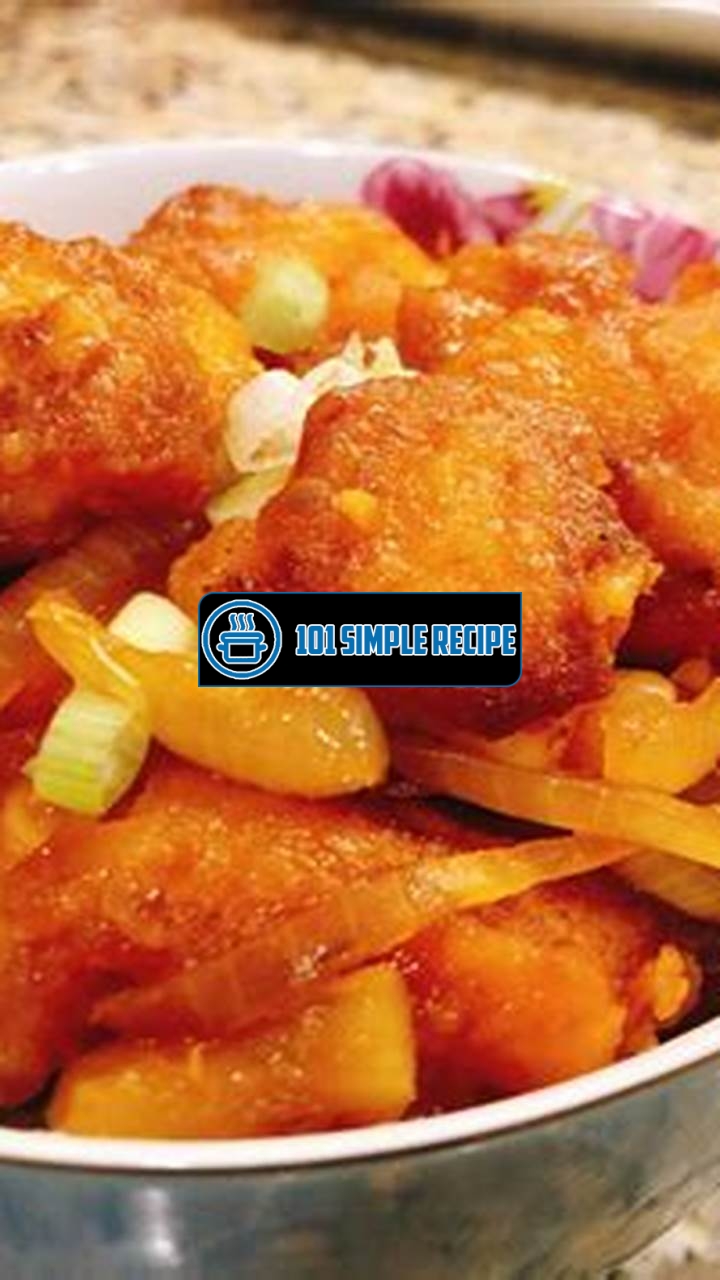Are you craving the delicious flavors of Chinese cuisine? Look no further! We bring you an irresistible recipe for Chinese Sweet and Sour Chicken, perfectly battered to achieve a crispy and golden exterior, paired with a tangy and sweet sauce that will tantalize your taste buds. This mouthwatering dish combines the perfect balance of flavors and textures, making it a favorite among Chinese food enthusiasts. Whether you’re looking to impress your family with a homemade Chinese feast or simply satisfy your own cravings, this recipe is sure to hit the spot. So, roll up your sleeves, grab your ingredients, and let’s get started on this delectable culinary adventure!

History of Chinese Cuisine
Chinese cuisine has a rich history that spans thousands of years, with its roots traced back to ancient times. This diverse and flavorful cuisine has captivated people all around the world, influencing the way we eat and cook.
Origins of Chinese Cuisine
The origins of Chinese cuisine can be traced back to the Paleolithic Era, when the Chinese people began hunting animals and gathering wild plants for sustenance. As their agricultural skills improved, they started cultivating crops such as millet, rice, and wheat.
During the Zhou Dynasty (1046-256 BCE), food became an important part of Chinese culture, and culinary skills were highly valued. The Chinese people developed a sophisticated understanding of food and its effects on the body, prompting the emergence of the concept of yin and yang in relation to diet.
Evolution of Chinese Cuisine
Over the centuries, Chinese cuisine continued to evolve, influenced by various factors such as geography, climate, and trade. The Silk Road, for example, played a significant role in introducing new ingredients and cooking techniques to China.
During the Tang Dynasty (618-907 CE), a golden age for Chinese cuisine, culinary arts reached new heights. The imperial court employed skilled chefs who created elaborate dishes that showcased the emperor’s wealth and power. It was during this time that the use of chopsticks became widespread.
The arrival of the Mongols in the 13th century also left a lasting impact on Chinese cuisine. The Mongols introduced ingredients such as lamb and dairy products, and their cooking techniques, such as stir-frying, became integral to Chinese cuisine.
Popular Dishes in Chinese Cuisine
Chinese cuisine boasts a wide array of popular dishes that have become beloved around the world. From dumplings to Peking duck, these dishes highlight the diverse flavors and techniques found in Chinese cooking.
- Sweet and Sour Chicken: A classic Chinese dish, sweet and sour chicken features battered and fried chicken pieces coated in a tangy sauce made with vinegar, sugar, and ketchup.
- Kung Pao Chicken: This spicy stir-fried dish is packed with flavor, combining chicken, peanuts, and dried chili peppers, all tossed together in a savory sauce.
- Mongolian Beef: Originating from the Mongolian influence on Chinese cuisine, Mongolian beef is a hearty dish made with thinly sliced beef, green onions, and a rich soy-based sauce.
- Hong Kong-style Dim Sum: Dim sum refers to a variety of bite-sized dishes commonly served in bamboo steamer baskets. These savory and steamed delights include dumplings, buns, and rice noodle rolls, among others.
As Chinese cuisine continues to evolve and adapt, it remains a popular choice for food enthusiasts and a testament to the rich culinary heritage of China.
Introduction to Sweet and Sour Chicken
Experience the tantalizing flavors and rich cultural heritage of sweet and sour chicken, a beloved dish in Chinese cuisine. This article will delve into the origins and traditional preparation techniques of this delectable meal. Get ready to embark on a culinary journey filled with bold and contrasting flavors that will leave your taste buds craving for more.
Origins of Sweet and Sour Chicken
The origins of sweet and sour chicken can be traced back to ancient China, where it was initially prepared with a unique combination of flavors. This dish originated in the Guangdong province, also known as Canton, which is famous for its Cantonese cuisine. The culinary experts of this region experimented with various combinations of ingredients to create a harmonious blend of sweet and sour flavors.
Traditionally, sweet and sour chicken was made by marinating tender pieces of chicken in a mixture of vinegar, sugar, and soy sauce. This marinade not only added flavor but also helped to tenderize the meat, creating a succulent and juicy texture. The chicken was then stir-fried with a medley of vegetables, such as bell peppers, onions, and pineapple, adding vibrancy and contrasting textures to the dish.
Over the years, the popularity of sweet and sour chicken spread to other parts of China and eventually to the rest of the world. Today, it is a staple in Chinese restaurants worldwide, captivating diners with its unique combination of sweet, sour, and savory flavors.
Key Ingredients in Sweet and Sour Chicken
The key ingredients in sweet and sour chicken are carefully selected to create a harmonious balance of flavors. Let’s take a closer look at the essential components:
- Chicken: Tender and boneless chicken breast or thigh are commonly used in this recipe. The meat is cut into bite-sized pieces, ensuring quick and even cooking.
- Vinegar: Vinegar, usually rice vinegar or apple cider vinegar, provides the tangy and sour element to the dish. It helps to cut through the richness of other ingredients and adds a refreshing acidity.
- Sugar: A combination of brown sugar and ketchup or tomato sauce is used to achieve the sweet component of the dish. The sugar caramelizes during the cooking process, adding depth and richness to the sauce.
- Soy sauce: Soy sauce adds a savory and umami flavor to the dish, enhancing the taste of the chicken and other ingredients.
- Vegetables: Colorful and crunchy vegetables such as bell peppers, onions, and pineapple are commonly used in sweet and sour chicken. These add texture, freshness, and a hint of natural sweetness to the dish.
Typical Cooking Techniques for Sweet and Sour Chicken
The cooking techniques used in preparing sweet and sour chicken play a vital role in achieving its distinctive taste and texture. The most commonly employed methods include:
- Marination: Marinating the chicken helps to infuse it with flavor and ensures a tender and juicy outcome. The chicken is often marinated in a mixture of soy sauce, vinegar, and sugar for a few minutes or up to an hour before cooking.
- Stir-frying: Stir-frying is the preferred cooking method for sweet and sour chicken. It involves quickly cooking the marinated chicken and vegetables in a hot wok or skillet over high heat. This technique allows for even cooking and helps to retain the color, crispness, and flavor of the ingredients.
- Sauce preparation: The sweet and sour sauce is prepared separately by combining vinegar, sugar, ketchup or tomato sauce, and other seasonings. This sauce is then added to the stir-fried chicken and vegetables, coating them evenly and creating a glaze that binds all the flavors together.
By following these cooking techniques, you can recreate the authentic taste and texture of sweet and sour chicken right in your own kitchen!
Embark on a culinary adventure with sweet and sour chicken by preparing this delightful dish at home. Enjoy the explosion of flavors and textures as you savor each bite of tender chicken, tangy sauce, and crisp vegetables. Whether you’re a fan of Chinese cuisine or simply looking to try something new, sweet and sour chicken is sure to satisfy your cravings and leave you wanting more!
If you want to try another yummy Chinese recipe, why not make our Hoisin Sauce? It’s the perfect accompaniment to many Asian dishes, including sweet and sour chicken.
The Art of Battering
When it comes to creating crispy and flavorful sweet and sour chicken, mastering the art of battering is essential. The batter acts as a protective layer that seals in moisture and enhances the overall texture and taste of the dish.
The Role of Batter in Chinese Cooking
In Chinese cooking, batter is a common technique used to achieve that desirable crispiness in various dishes. It provides a crispy coating on meats, seafood, and vegetables, keeping them tender and moist on the inside while creating a delightful crunch on the outside.
Not only does battering help to achieve texture, but it also adds flavor to the dish. The ingredients in the batter can include a combination of spices, herbs, and sauces that infuse the food with additional taste and aroma. This is especially important in sweet and sour chicken, as the batter serves as a base for the tangy and sweet sauce.
Types of Batters Used in Sweet and Sour Chicken
There are several types of batters commonly used in sweet and sour chicken recipes, each offering a unique texture and flavor profile. One popular option is a simple cornstarch-based batter, which results in a light and crispy coating. Another choice is a tempura-style batter made with a mixture of flour, egg, and cold water. This type of batter creates a delicate and airy crust.
For those who prefer a thicker and crunchier coating, a bread crumb or panko batter can be used. These breadcrumbs, combined with flour and seasonings, create a more substantial texture and provide a satisfying crunch when fried.
Tips for achieving the perfect batter consistency
To achieve the perfect batter consistency for your sweet and sour chicken, it’s important to follow these tips:
- Use ice-cold water or club soda in your batter. The cold temperature helps to create a lighter and crisper texture.
- Whisk the batter until it is smooth and free of lumps. This ensures an even coating on the chicken and prevents clumps from forming.
- Let the batter rest for a few minutes before using it. This allows the ingredients to blend together and creates a more cohesive and flavorful coating.
- Adjust the thickness of the batter by adding more liquid or flour as needed. The consistency should be similar to a thick pancake batter.
- Dip the chicken pieces into the batter just before frying. This helps to keep the chicken moist and ensures the coating adheres well.
By mastering the art of battering and following these tips, you can achieve crispy and flavorful sweet and sour chicken that will impress your family and guests. So go ahead, grab your ingredients, and get ready to create a delicious Chinese-inspired dish that will delight your taste buds!
If you’re looking for more delicious recipes, check out our Sweet and Sour Chicken Recipe. It’s a classic Chinese dish that is sure to satisfy your cravings.
The Sweet and Sour Sauce
Delve into the secrets behind the tangy and flavorful sauce that accompanies sweet and sour chicken.
Components of the Sweet and Sour Sauce
The sweet and sour sauce is a key element that enhances the flavors of the crispy battered chicken. Made from a combination of ingredients, this sauce tantalizes your taste buds with its signature tanginess and sweetness. Let’s take a closer look at the components that make up this delicious sauce.
- Vinegar: An essential ingredient in sweet and sour sauce, vinegar provides the tangy flavor that balances out the sweetness. Rice vinegar or apple cider vinegar are commonly used sources of acidity.
- Sugar: To achieve the perfect sweet and sour balance, sugar is added to the sauce. Brown sugar is often used for its rich flavor and caramel notes.
- Ketchup: Adding a touch of tomato flavor and vibrant red color, ketchup acts as a base ingredient in the sauce.
- Soy sauce: To impart a savory umami taste, soy sauce is included in the sauce. It adds depth and richness to the overall flavor profile.
- Pineapple juice: This tropical fruit juice adds a natural sweetness and fruity aroma to the sauce. It complements the flavors of the chicken and provides a delightful tang.
- Cornstarch: Cornstarch is used as a thickening agent. It gives the sauce a glossy appearance and enables it to adhere well to the chicken.
Variations of Sweet and Sour Sauce
While the classic sweet and sour sauce recipe is a popular choice, there are several variations that offer unique flavors and textures. These variations cater to different preferences and culinary traditions. Here are a few notable ones:
- Spicy Sweet and Sour Sauce: For those who enjoy a bit of heat, adding chili flakes or sriracha sauce can give the sauce a spicy kick. It adds an exciting twist to the traditional recipe. ️
- Pineapple Sweet and Sour Sauce: By incorporating chunks of fresh pineapple or pineapple juice with the other ingredients, you can elevate the fruity sweetness of the sauce. It pairs exceptionally well with chicken and gives a tropical touch to the dish.
- Ginger-Garlic Sweet and Sour Sauce: Adding minced ginger and garlic to the sauce brings an aromatic and robust flavor. It adds complexity and depth to the overall taste experience.
Tips for Achieving the Ideal Sweet and Sour Sauce Consistency
Consistency is key when it comes to the sweet and sour sauce. Here are some tips to help you achieve the perfect texture:
- Gradually add cornstarch: To avoid clumps in the sauce, it’s essential to dissolve the cornstarch in a small amount of water before adding it to the other ingredients. This ensures a smooth and even consistency.
- Thicken over low heat: Heat the sauce over low heat to avoid scorching and to allow the cornstarch to thicken the mixture gradually. Stir continuously to prevent lumps from forming.
- Adjust sweetness and tanginess: Taste the sauce as you go and adjust the sweetness and tanginess according to your preference. You can add more sugar for extra sweetness or vinegar for a stronger tang.
- Strain for a smoother texture: For a smoother sauce, strain it through a fine-mesh sieve to remove any remaining lumps or impurities. This step ensures a velvety texture that coats the chicken perfectly. ️
Mastering the art of making the sweet and sour sauce is essential to creating an authentic and delectable Chinese sweet and sour chicken. With these tips and variations, you can elevate this classic dish to new heights of flavor. Enjoy the tangy, crispy goodness!
Looking to expand your Chinese cuisine repertoire? Try our Shrimp Teriyaki Recipe. It’s a delicious and easy-to-make dish that combines the flavors of Chinese and Japanese cuisine.
The Battering Process
When it comes to creating the perfect Chinese sweet and sour chicken, the battering process plays a crucial role in achieving the desired texture and flavor. The right technique can make all the difference between a crispy and evenly coated chicken and a soggy, clumpy mess. Here, we will guide you through the step-by-step instructions on how to properly batter the chicken for the perfect texture and flavor.
Preparing the Chicken Pieces for Battering
Before embarking on the battering process, it is essential to prepare the chicken pieces properly to ensure they are ready to be coated and fried to perfection. Start by choosing boneless, skinless chicken thighs or breasts, as they work best for this dish.
- Cut the chicken into bite-sized pieces, ensuring they are all similar in size. This will ensure even cooking and a consistent texture.
- Season the chicken with salt and pepper to enhance its flavor.
- In a separate bowl, prepare the batter mixture, which typically consists of all-purpose flour, cornstarch, baking powder, and water. You can add your desired seasonings, such as garlic powder or paprika, to elevate the taste.
The Battering Technique for Sweet and Sour Chicken
Once the chicken pieces are adequately prepared, it’s time to move on to the actual battering process. Follow these steps to achieve the perfect coating:
- Dip each chicken piece into the batter, making sure it is fully coated.
- Allow any excess batter to drip off before moving on to the next step.
- Place the battered chicken on a wire rack or a plate to rest for a few minutes. This allows the batter to set and adhere to the chicken properly.
- While the chicken is resting, heat a generous amount of oil in a deep fryer or a large, deep pan. Ensure it is hot enough to fry the chicken to a golden brown crispiness.
- Carefully add the battered chicken to the hot oil, ensuring not to overcrowd the pan. Fry the chicken in batches if necessary.
Pro Tips for Achieving a Crispy and Evenly Battered Chicken
To take your Chinese sweet and sour chicken to the next level, here are some pro tips to keep in mind:
- Temperature control: Maintaining the correct oil temperature is crucial for achieving a crispy exterior and a juicy interior. Too low heat will result in greasy chicken, while too high heat can burn the batter.
- Drain excess oil: Once the chicken is fried to perfection, place it on a paper towel-lined plate or rack to drain any excess oil.
- Serve immediately: Sweet and sour chicken is at its best when served immediately. The longer it sits, the more likely it is to lose its crispy texture.
Remember, mastering the battering process is the key to creating a Chinese sweet and sour chicken that is crispy, flavorful, and simply irresistible. So, follow these step-by-step instructions and pro tips to achieve the perfect texture and flavor every time you make this delicious dish.
Thank you for reading our article on the Chinese sweet and sour chicken recipe with a crispy batter. We hope you enjoyed learning how to recreate this popular dish in your own kitchen. If you try out the recipe, don’t forget to share your feedback and experiences with us. We love hearing from our readers!
Frequently Asked Questions
Here are some common questions about our Chinese sweet and sour chicken recipe:
| No. | Questions | Answers |
|---|---|---|
| 1. | Can I use a different type of meat instead of chicken? | Absolutely! While chicken is the traditional choice for this recipe, you can try using pork, shrimp, or tofu as well. Just adjust the cooking time accordingly. |
| 2. | Can I make the batter in advance? | It’s best to make the batter right before frying the chicken to ensure it stays crispy. However, you can prepare the dry ingredients in advance and mix the wet ingredients just before frying. |
| 3. | What should I serve with sweet and sour chicken? | Sweet and sour chicken pairs well with steamed white rice or fried rice. You can also add some stir-fried vegetables on the side. |
| 4. | Can I use store-bought sweet and sour sauce? | Yes, you can use store-bought sauce if you’re short on time. However, making your own sauce from scratch will give you a more authentic and flavorful taste. |
| 5. | How can I make the dish less sweet? | If you prefer a less sweet taste, you can reduce the amount of sugar or use a lower-sugar alternative. You can also add a bit more vinegar or lime juice to balance out the flavors. |
| 6. | Is it possible to make this dish gluten-free? | Yes, you can make this dish gluten-free by using a gluten-free flour substitute for the batter, and ensuring the other ingredients, such as soy sauce and vinegar, are gluten-free as well. |
Jump to Recipe
Chinese Sweet and Sour Chicken Recipe

Learn how to make crispy Chinese sweet and sour chicken with this delicious recipe. The chicken is coated in a light and crispy batter, then tossed with a tangy and flavorful sweet and sour sauce. It’s the perfect dish to satisfy your Chinese takeout cravings at home.
- 1 pound boneless (skinless chicken breasts)
- 1/2 cup all-purpose flour
- 1/2 cup cornstarch
- 1 teaspoon baking powder
- 1/2 teaspoon salt
- 1/2 cup cold water
- 1/2 cup club soda
- 1 egg
- 2 cups vegetable oil (for frying)
- 1/2 cup ketchup
- 1/4 cup rice vinegar
- 3 tablespoons brown sugar
- 2 tablespoons soy sauce
- 1 tablespoon cornstarch
- 1/2 cup pineapple chunks (optional)
- 1/2 cup bell pepper chunks (optional)
- Cut the chicken breasts into bite-sized pieces and set aside.
- In a large bowl, whisk together the flour, cornstarch, baking powder, and salt. In a separate bowl, whisk together the cold water, club soda, and egg. Gradually pour the wet ingredients into the dry ingredients, whisking until the batter is smooth and well combined.
- Heat the vegetable oil in a deep pan or skillet over medium-high heat. Dip the chicken pieces into the batter, allowing any excess to drip off, and carefully place them into the hot oil. Fry the chicken in batches for 4-5 minutes, or until golden brown and cooked through. Transfer the fried chicken to a paper towel-lined plate to drain off any excess oil.
- In a small saucepan, combine the ketchup, rice vinegar, brown sugar, soy sauce, and cornstarch. Cook over medium heat, stirring constantly, until the sauce thickens and becomes glossy.
- Transfer the fried chicken to a large bowl and pour the sweet and sour sauce over the top. Gently toss to coat the chicken pieces in the sauce. If desired, add pineapple chunks and bell pepper chunks for extra flavor and color.
- Serve the Chinese sweet and sour chicken over steamed white rice or fried rice. Garnish with sesame seeds and sliced green onions, if desired. Enjoy the homemade version of this classic Chinese dish!






